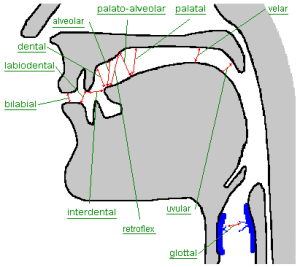Consonant Sounds 4: Place of Articulation
Place of Articulation:
Video Explanation:
The two components used to make consonant sounds are:
1) The place of articulation (the ‘where’ the sounds are made)
-and-
2) The articulators (the ‘what’ are used to make the sounds)
The ‘articulators’ are the instruments (e.g. your tongue) used to make a sound. The locations on the mouth, where the articulators are placed, are the ‘places of articulation’.
Example:
The two lips (the articulators) meet to form the bilabial sounds of /b/ and /p/.
The tip of the tongue – the articulator – meets with the alveolar ridge – the place of articulation (which is right behind the front teeth) – in order to form the alveolar sounds of /d/ and /t/.
There are seven places of articulation used to distinguish consonant sounds:
Places of Articulation
Bilabial (or ‘two lips’): Produced with the two lips: /b, p, m, w/ (as in ‘buy, pie, my, and wool’).
Labiodental (or ‘lip and teeth’): Produced with the upper teeth and inner lower lip: /f, v/ (as in ‘feel and veal’).
Interdental (or ‘between teeth’): Produced with the tongue tip on or near the inner surface of the upper teeth: /θ/, /ð/ (as in ‘thick and then’).
Alveolar (or ‘behind teeth’): Produced with the tongue tip on or near the tooth ridge: /t, d, s, z, n, l/ (as in ‘to, do, zoo, new, and light’).
Palatal (or ‘top middle of mouth’): Produced by the body of the tongue touching the roof of the mouth (in the palatal area): /ʃ, ʒ, ʧ, ʤ, r, j-y/ (as in ‘shin, genre, chef, judge, red, and yes’).
*Note that the /ʃ, ʒ, ʧ, ʤ/ sounds are all pronounced with the front of tongue places on the top of mouth while the /j-y/ one is pronounced with more of the rear of the tongue placed a bit further back on the palate than /ʃ, ʒ, ʧ, ʤ/. Finally, the /r/ sound is made with the sides of the tongue placed on the sides of the roof of the mouth pressed against the teeth.
Velar (or ‘top of throat’): Produced with the tongue body on or near the soft palate: /g, k, ŋ/ (as in ‘go, kite, and bang’).
Glottal (or ‘from the throat’): Produced by air passing from the windpipe through the vocal cords: /h/ (as in ‘hi’).
Chart Awareness:
Referring back to the Underhill chart (1996) the consonant sounds have been organized in the first two rows, from left to right, by a progression of moving the place of articulation farther back in the mouth e.g. the first row begins with the bilabial /p/ (front of mouth) and ends with the velar /g/ (back of mouth).
Place of Articulation: First Two Rows
| p | b | t | d | ʧ | ʤ | k | g |
| f | v | θ | ð | s | z | ʃ | ʒ |
| bilabial | bilabial | alveolar | alveolar | palatal | palatal | velar | velar |
| labiodental | labiodental | interdental | interdental | alveolar | alveolar | palatal | palatal |
Movement of tongue —————————————————————————->
NOTE: The third row does not follow any particular pattern concerning the place of articulation.
| m | n | ŋ | h | l | r | w | j/y |
| Bilabial | Alveolar | Velar | Glottal | Alveolar | Palatal | Bilabial | Palatal |
Comprehension Check: Quiz Time!
Phonology Quiz 5: Place of Articulation
